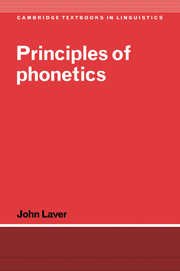Book contents
- Frontmatter
- Contents
- List of figures
- List of tables
- Preface
- Acknowledgements
- Introduction
- PART I General concepts
- PART II The analytic framework
- 4 The phonetic analysis of speech
- 5 The architecture of phonetic classification
- PART III Initiation and phonation
- PART IV Linear segmental analysis
- PART V Articulatory co-ordination and phonetic settings
- PART VI Temporal, prosodic and metrical analysis
- PART VII Principles of transcription
- PART VIII Conclusion
- Envoi
- Appendix I The phonetic alphabet of the International Phonetic Association
- Appendix II Index of languages
- References
- Index of names
- Subject index
5 - The architecture of phonetic classification
Published online by Cambridge University Press: 05 June 2012
- Frontmatter
- Contents
- List of figures
- List of tables
- Preface
- Acknowledgements
- Introduction
- PART I General concepts
- PART II The analytic framework
- 4 The phonetic analysis of speech
- 5 The architecture of phonetic classification
- PART III Initiation and phonation
- PART IV Linear segmental analysis
- PART V Articulatory co-ordination and phonetic settings
- PART VI Temporal, prosodic and metrical analysis
- PART VII Principles of transcription
- PART VIII Conclusion
- Envoi
- Appendix I The phonetic alphabet of the International Phonetic Association
- Appendix II Index of languages
- References
- Index of names
- Subject index
Summary
The immediately following chapters are devoted in turn to a detailed consideration of each strand of vocal performance, from airstream mechanisms, phonation and articulation to prosodic, temporal and metrical organization. But this method of presentation, desirable though it is in other ways, is difficult to absorb without some initial frame of reference in which to integrate the different pieces of information. This chapter therefore begins with a brief sketch of the way that speech is typically performed, in order to give the reader a preliminary orientation.
The body of the chapter is then taken up with a summary of the principles on which speech can be classified at both the segmental and the suprasegmental levels of analysis. This offers the reader an overview of the architecture of the theoretical model to be developed in this book, before embarking on the full detail of segmental and suprasegmental description in the later chapters. Highlighting the main elements of theoretical structure in this way has the disadvantage that this chapter covers a great deal of ground very cursorily. But it may also have the compensating advantage of providing a summary to which the reader can return for review purposes after reading the later chapters.
A frame of reference for the production of speech
The basic function of the vocal apparatus in producing speech is to create audibly different patterns of sound. This can only be achieved by using the vocal apparatus to produce noises whose auditory quality, pitch, loudness and duration can be varied at will.
- Type
- Chapter
- Information
- Principles of Phonetics , pp. 119 - 158Publisher: Cambridge University PressPrint publication year: 1994



